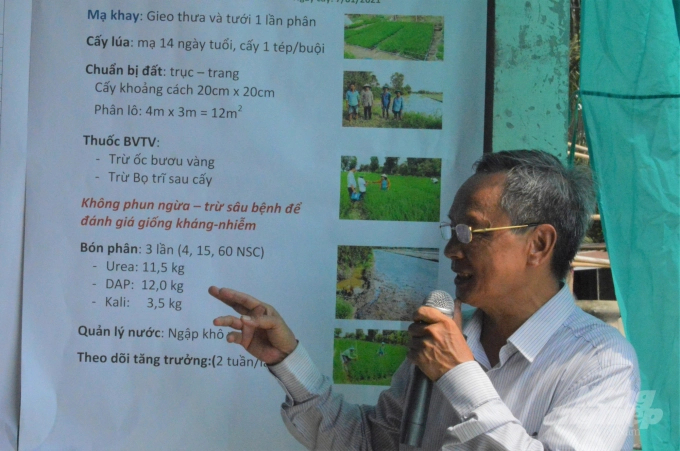June 20, 2025 | 15:19 GMT +7
June 20, 2025 | 15:19 GMT +7
Hotline: 0913.378.918
June 20, 2025 | 15:19 GMT +7
Hotline: 0913.378.918
Dozens of new rice varieties were bred from wild rice genetic resources to increase the resistance to drought, salinity, pests, and diseases, and adapt to climate change, heard a workshop held recently in Hau Giang province.
The workshop, which was organized by the Mekong Delta Development Research Institute (MDI), under Can Tho University, is aimed at evaluating rice varieties adaptable to climate change.
It drew the participants of more than 40 delegates including representatives from the provincial, district agricultural agencies, farmers, and scientists.

Most rice varieties on experiments are proven to be resistant to blast disease and brown planthopper which reduce production in project sites. Photo: Trung Chanh.
Huynh Quang Tin, from MDI, said the workshop is a part of the cooperation between Can Tho University and farmers' group knowns as Seeds clubs in the implementation of the project entitled “Participatory Evaluation of Crop Wild Relative Introgressed Genetic Resources in Rice in the Mekong Delta, Vietnam.”
All rice varieties that are developed are a combination of the local wild rice ancestor, Oryza rufipogon and IR154, which is researched and selected by the International Rice Research Institute (IRRI), he said.
The new rice varieties are expected to be better tolerant to drought, salinity, insects, and diseases thanks to the wide adaptability of the wild rice.
To assess the varieties' response to each location, they are being cultivated in some localities including Hau Giang Province’s Long My Town, Vinh Long Province’s Long Ho District, Tien Giang province’s Cai Be District, An Giang Province’s Chau Phu District, and Bac Lieu Province’s Vinh Loi District, Tin said.
Phan Van Oanh, a farmer engaged in the project said the varieties have been selected to grow in the 2020-2021 winter-spring crop.
He said the rice field is about to be harvested soon and promising a high yield.
They have proven to be resistant to diseases, Tin said, adding that no pesticides had been used.
Vo Kim Luong, head of Plant Protection Station of Long My Town said all 26 varieties in the experiments weren't affected by pests, diseases, or brown planthoppers at the vegetative stage. Some varieties were infected with blast disease in the reproductive stage but at a mild level.
The wild species of Oryza are regarded as a valuable resource for rice improvement because of their high genetic diversity, according to experts.

Assoc. Prof. Huynh Quang Tin introduces the characteristics and cultivation process of rice varieties that are crossed with wild rice genetic resources to adapt to climate change. Photo: Trung Chanh.
They said Oryza is regarded as the ancestor of the current cultivated rice variety.
In the world, scientists have discovered 26 species of wild rice. Vietnam has four wild rice species, namely Oryza officinalis, Oryza rufipogon, Oryza nivara và Oryza granulata.
The Oryza rufipogon population was found in the Mekong Delta and southest provinces, especially in the Tram Chim area in Dong Thap Muoi (Plain of Reeds). This rice variety is considered by local people as “ghost rice” for its ability to survive flooding.
The rice variety has genes that scientists use to create new rice varieties as the rice can grow in alum-affected soil and is highly resistant to diseases transmitted by brown planthoppers and white-backed planthoppers, and can grow in deep floodwater.
Le Minh Thang, deputy director of Hau Giang Agricultural Service and Extension Centre, said farmers’ farming practices have been improved over the past years. The linkage between production and consumption and the expansion of large-scale rice fields have helped bring about sustainability for rice production.
However, he said, climate change has increased drought, saltwater intrusion, and pests, causing much damage to farmers.
In response to the situation, farmers must have varieties that can adapt to local environmental conditions, reducing damage for farmers while increasing their incomes.
Once the new rice strains are proved to be effective in dealing with insects, diseases, salinity, and drought, they should be put into production to promote the role of varieties and give more options for farmers, Thang said.
![Turning wind and rain into action: [9] Digitizing hydrometeorological data in response to climate change](https://t.ex-cdn.com/nongnghiepmoitruong.vn/608w/files/news/2025/06/17/z6704423696987_15fd32ffc26d590d204d520c9dac6786-nongnghiep-165943.jpg)
(VAN) Farmers have begun accessing hydrometeorological applications to adjust their cropping schedules, aiming to ensure productivity and adapt to climate change.
![Turning wind and rain into action: [8] Real-time salinity detection and early warning technology](https://t.ex-cdn.com/nongnghiepmoitruong.vn/608w/files/news/2025/06/17/z6704423696987_15fd32ffc26d590d204d520c9dac6786-nongnghiep-151127.jpg)
(VAN) Thanks to the integration of modern hydrological-hydraulic models, remote sensing technologies, and artificial intelligence, the accuracy of hydrological forecasting has significantly improved.
![Turning wind and rain into action: [7] Early disaster warnings help marine farmers minimize losses](https://t.ex-cdn.com/nongnghiepmoitruong.vn/608w/files/news/2025/06/17/z6704423696987_15fd32ffc26d590d204d520c9dac6786-nongnghiep-142942.jpg)
(VAN) In recent years, thanks to early disaster warnings and forecasting, marine farmers in Khanh Hoa province have been able to reduce risks and losses, thereby improving production efficiency.
![Turning wind and rain into action: [6] ‘Four on-the-spot’ disaster management software](https://t.ex-cdn.com/nongnghiepmoitruong.vn/608w/files/news/2025/06/17/e5a48259d6a262fc3bb3-nongnghiep-183800.jpg)
(VAN) By simply activating the scenario on the disaster management software, the relevant authorities immediately know how many households need to be evacuated, where to evacuate them to, and by what means of transportation…
![Turning wind and rain into action: [5] Hue applies modern technology in disaster forecasting](https://t.ex-cdn.com/nongnghiepmoitruong.vn/608w/files/news/2025/06/17/z6704423696987_15fd32ffc26d590d204d520c9dac6786-nongnghiep-093938.jpg)
(VAN) In Hue city, modern technology has recently been applied in meteorological and hydrological forecasting and warning, helping to reduce the damage caused by natural disasters.

(VAN) A cutting-edge farming technique being implemented on an experimental ranch in Arizona's Sonoran Desert has already saved a billion gallons of water over five years, according to Civil Eats.

(VAN) Poultry and pig production and the environment can be boosted through enhanced water technology, according to new research.